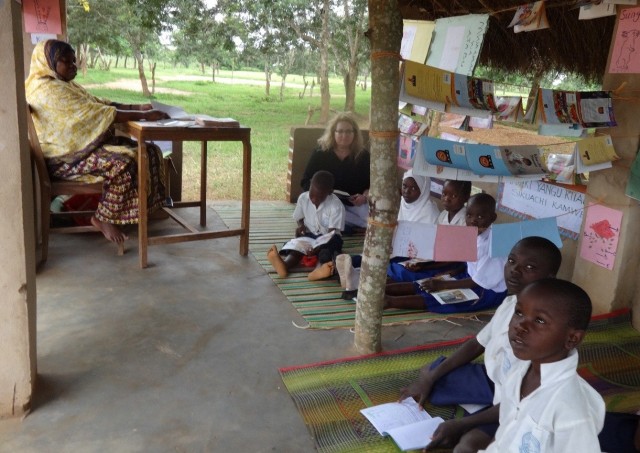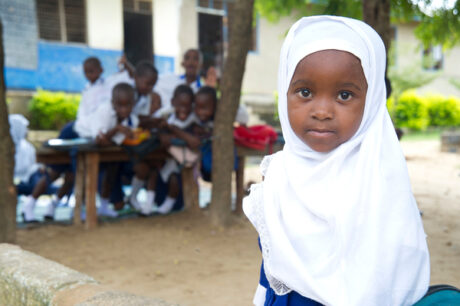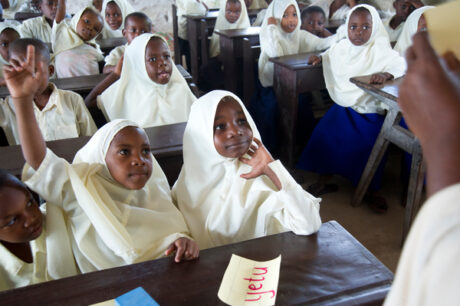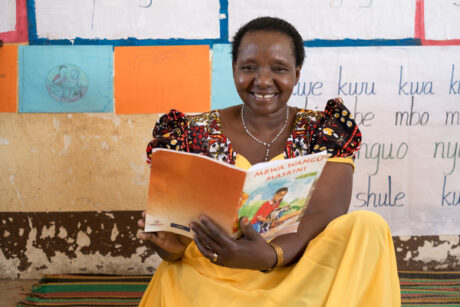
In a sheltered outdoor reading space, I ask a group of kids if I can bring my book and join them. They warmly welcome me as I settle down next to them on brightly colored rugs. They ask me about the book I am reading.
“It’s called The Alligator Man, by James Sheehan,” I say. “It’s a tale about a mean, greedy man who gets eaten by a big, ol’ alligator when he is walking past the local swamp one dark night.”
Their eyes get big with excitement as they scoot closer to me on the rug.
That morning, we had traveled four hours crammed into an SUV, bumping along dirt roads while avoiding huge potholes, and swapping stories about our lives to pass the time. Luckily, it was still cool outside; the summer heat and humidity were not yet at their peak.
Finally, we arrived at Chaume Primary School in rural Mtwara, Tanzania. I peeked into the classroom entrance and smiled at the room full of children sitting obediently at their desks.
I saw the teacher using a solar powered laptop to teach her students how to read. She was showing short videos to students for early grade reading instruction. The students then practiced what they learned in small groups.
In a nearby school library, students were quietly reading books – large, medium and “pocket” sized – that are printed or even hand-made by teachers and other students. The books were colorful, with fun, culturally relevant short stories.
In primary schools like Chaume, Creative is running the Tanzania 21st Century Basic Education Program to train teachers on engaging classroom methods and the use of technology to help kids learn to read. The program works in the Mtwara region of southeast mainland Tanzania, and on the islands of Unguja and Pemba in Zanzibar, and is funded by the U.S. Agency for International Development.
It builds government capacity to train teachers on these approaches, and also trains administrators and selected teachers to use education management information system for improved school management.
Most importantly, Creative is trying to stimulate an interest in reading, not just for learning other school subjects, but also for fun. Having access to age-appropriate books at school and at home is a big part of that effort.
I was so impressed by what I saw at Chuame. The classroom of 60 kids in second grade was really engaged and interested in the subject matter. Most were raising their hands to answer questions. When they were split into groups of four to continue practicing letter and word recognition, they got right to work.
The school yard, clean-swept with flower beds and trees planted all around, was also painted with words and sentences for young readers to sound out. White-washed classrooms had colorful posters and slogans to capture the eye, and encourage reading.
The kids seem very interested in reading—both their books and mine. They surround me on the rug in the outdoor reading space and clamor to hear more of the story about the “big ol’ alligator.” Their smiles are large and excited.
In turn, they teach me Kiswahili for crocodile (mamba), frog (chura) and elephant (tembo). With their help, I say each word out loud and practice.
Later on, they draw pictures of the animals with their Kiswahili names so I won’t forget what I’ve learned. The kids write their names and the date below the pictures so I don’t forget them, either. Now tacked up on the wall over my desk, that piece of paper – and the memory that goes with it – means I never will.
Anne Woodworth is the Director of Business Development for Creative’s education programming.



